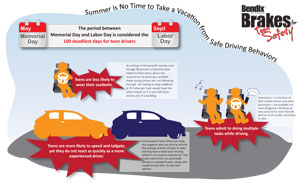While most people may assume that teens driving in the thick of winter – when it’s dark, cold and wet – would be more dangerous than driving on sunny, warm days, a recent study from AAA states it is actually the summer months that are the most dangerous. In fact, the period between Memorial Day and Labor Day is considered the 100 deadliest days for teen drivers.

“Teens are spending much more time in the car during June, July and August – since they’re out of school and traveling with friends more often,” said Shannon Lara, senior manager, marketing communications for Honeywell Friction Materials. “Sadly – on July 4 alone – an average of 28 teenagers die in motor vehicle crashes.”
Bendix Brakes for Teen Safety, a campaign aimed at educating parents and teens on safe driving and vehicle care, is launching its third video to help bring attention to this dangerous driving season, and alleviate potential problems by making parents and teens aware of three key risk factors that could affect their summer driving.
1. Teens are more likely to speed and tailgate, yet they do not react as quickly as a more experienced driver. A Honeywell Friction Materials study also suggests teens are driving vehicles that average at least 10 years or older and may have a badly worn braking system if not properly maintained. That means new drivers are potentially relying on outdated brakes, along with inexperienced skills, to stop their vehicles.
2. Teens are less likely to wear their seatbelts. According to Honeywell’s survey, even though 90 percent of parents have talked to their teens about the importance of wearing a seatbelt, these young drivers are not following through. Yet having to stop suddenly at 30 miles per hour would have the same impact as if a teen fell three stories out of a building.
3. Teens admit to doing multiple tasks while driving. Distractions – in the form of both mobile devices and other passengers – are probably the most dangerous risk factor as they account for more than 80 percent of all crashes, according to AAA.
During summer, there is no shortage of teens driving together – but Bendix Brakes for Teen Safety suggests parents limit the number of passengers in their teen’s vehicle, as data from AAA reveals that having one teen passenger could double a young driver’s risk of getting into a fatal crash, while having three or more quadruples their risk.
“Helping teens and parents become more aware of how dangerous these risk factors are is key to curbing the number of accidents and crashes,” said Lara. “That’s why we will continue to promote safe driving habits that start before teens even turn the key.”
Visit Bendix Brakes for Teen Safety on Facebook or YouTube for the latest educational video and for more useful tips and information on being a safe teen driver.
Friction Materials LLC, a business unit of Honeywell International Inc., is headquartered in Glinde, Germany. Serving both original equipment and aftermarket customers, products offered include Bendix and Jurid friction materials and hard parts. For more information, log on to www.bendixbrakes.com.













